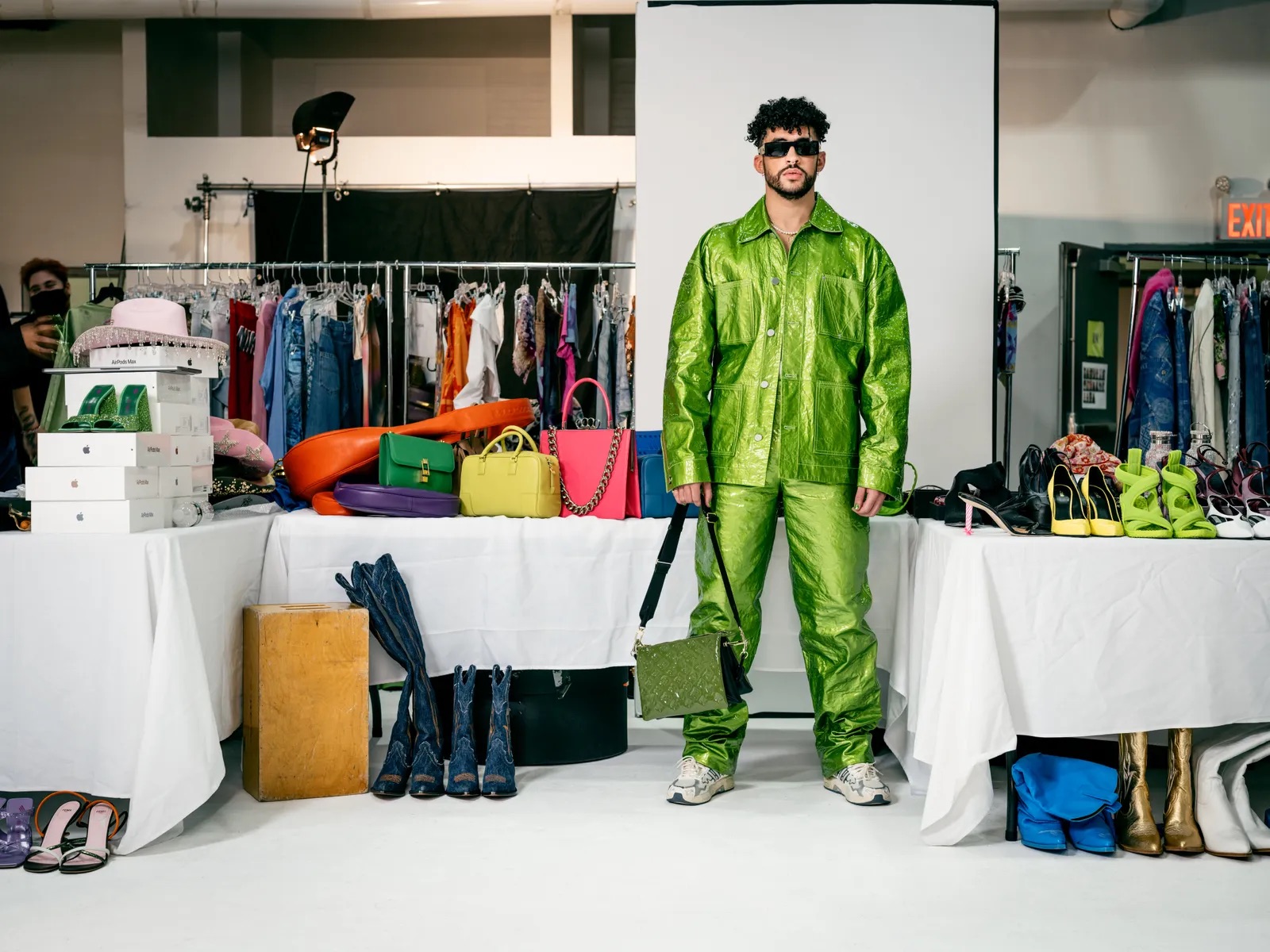Throughout his career, Benito Martínez Ocasio, more commonly known as Bad Bunny, has not only had an impact on the Latin music industry but also distinguished himself from other male reggaeton artists. Since his formal entry into the music scene in 2016, he has challenged societal norms visually through his bold and transformative fashion choices. As a reggaetonero emerging from the hypermasculine genre of Latin trap, his evolution in style serves as a performance of both gender fluidity and wealth. From the start of his career to the present day, there is a visible shift in Bad Bunny’s appearance and fashion choices, which is closely paralleled to the amount of success he has acquired throughout the years. There is also a consistent play with gender norms at different points in his career, but this engagement has ranged from subtle to explicit, revealing a deliberate and evolving approach to self-expression and advocacy. His early days embracing bright, flamboyant streetwear to recently modeling designer handbags in Vogue point to a dual relationship between gender and wealth that define Bad Bunny’s fashion trajectory. This visual evolution is particularly significant within the context of reggaeton and Latin trap, genres traditionally steeped in hypermasculinity. Through this lens, Bad Bunny has become not only a style icon but also a symbol of progress for the Latin music industry, with the ability to attract audiences globally and turn heads with an outfit.
The Hypermasculine Context:
To understand this fashion evolution, it is important to consider the Latin trap culture that Bad Bunny began his career with. Luis Rivera Figueroa (2021) provides a necessary basis for understanding Puerto Rican trappers, describing them as a “sexual-driven, violence-oriented, and wealth-flaunting masculine performance” (92). He further contrasts the trap scene from contemporary reggaeton music for its explicit and vulgar lyrics that featured the typical masculine performance found in the genre, particularly in a “pornographic register” (94). These were the dominating attitudes of the Puerto Rican trap genre, which consequently formed a hegemonic hypermasculinity that was typically associated with not only Puerto Rican trappers but Latin artists across the region that adopted this culture. When Bad Bunny entered this scene, he would adhere to this hegemonic performance by hypersexualizing women in his lyrics, presenting as a drug lord, player, and pimp in his music videos, and name-dropping luxury brands to make his material success known. However, he would simultaneously diverge from this framework through his fashion, which Rivera Figueroa described as “unconventional,” “eccentric,” and his “distinctive quality” (95). It is significant that it was not his music that differentiated him from other trap artists during this period; instead, it was his appearance that was out of place and made him attractive to the media. As Rivera Figueroa points out, emerging trap artists were able to take advantage of the “precious cultural capital” that this dominant form of masculinity offered them, but Bad Bunny, despite following the vulgar narrative through his music, garnered more attention and fame through his transgressive fashion.
To fully grasp the transgressive nature of Bad Bunny’s fashion choices, it is important to consider Malcolm Barnard’s (1996) theory of fashion as a form of communication and its role in reflecting and reshaping cultural norms. Barnard’s work explores how clothing not only signifies individual identity but also interacts with societal structures such as hegemony, which he defines as “the situation that exists when certain social groups…in positions of dominance are able to exert their social authority as a result of their power appearing and being experienced as natural and legitimate” (95). Fashion as a form of communication then, reproduces these positions of dominance but also has the power to reshape them and appear natural. This is why Bad Bunny’s fashion is distinctive amidst the hegemony of hypermasculinity in the trap genre: it communicates a reformation of the current dominant norm. The source continues by describing hegemony as a “moving equilibrium,” suggesting that cultural norms, including those regarding gender and power, are not fixed but must be continuously re-established. Bad Bunny as a disruptor of hegemony has the power to continuously disrupt his own positions of power, especially as he becomes more comfortable with ideas of self-expression and identity. A similar framework can be seen within the genre of hip-hop, where the diversification of rap introduced a more stylish genre, one that married heavy gold chains and baggy pants with high fashion leather and fur (Wilbekin, 2020). This combination replaced the purely urban style that characterized hip-hop and can now be seen as natural and legitimate due to fashion’s power as a form of communication. Bad Bunny’s evolution in fashion reflects this dynamic, as his bold statements through clothing since the start of his career serve to disrupt the existing equilibrium of masculinity in Latin trap and, eventually, reggaeton and Latin pop.
The Early Trap Style:
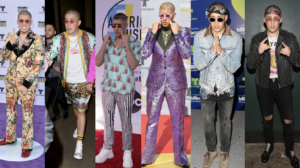
Various Bad Bunny red carpet looks from 2016-2018.
It is impossible to visualize a fashion evolution without first viewing Bad Bunny’s early trap style. The image above depicts various red carpet looks during his trap era and leading up to the release of his first full album. At first glance, it is easy to be attracted to the bright colors he employs in each of his outfits, but a closer analysis demonstrates some degree of adherence to the hypermasculine aesthetic described above. Designer logos, flashy accessories, and streetwear staples such as denim are featured elements that are synonymous with the style of Latin trappers. Some of these red carpet looks incorporated pieces from high fashion houses like Gucci and Prada (Takanashi & Destefano, 2023). Despite his attempt to flaunt his wealth in true trapper fashion, Bad Bunny’s early trap style was already beginning to challenge the rigid norms of hypermasculinity within this genre. His use of eccentric patterns, vibrant colors, floral combinations, and clashing prints overpowers any attempt he could have made to present a masculine performance. These were the looks that distinguished him from his peers and challenged traditional gender norms, including his use of painted nails. Even in his early career, Bad Bunny used his style to hint at the fluidity and individuality that would come to define his public image, and the media were certainly paying attention.
Subtle Gender Fluidity in “Caro”:
Bad Bunny’s “Caro” music video serves as a pivotal moment in his early career where he begins to explore gender fluidity more explicitly through fashion and visual storytelling. The video features a female alter ego who not only embodies Bad Bunny for the majority of the video but also wears the same outfit he does, which effectively blurs the lines between traditionally masculine and feminine styles. This deliberate mirroring emphasizes the fluidity of identity, as the female character becomes an extension of Bad Bunny rather than a separate figure. Additionally, the close-up shots of his painted nails stand out as a quiet act of defiance. Given that Bad Bunny had previously spoken about being turned away from a nail salon in Spain due to his gender (Herrera, 2018), the display of his nails in “Caro” becomes a statement of resistance against societal expectations. The music video also shows the female alter ego with a group of masculine figures in the background, further subverting the norms of Latin trap as the video moves away from the genre’s typical hypermasculine themes of violence and the sexualization of women. Instead, “Caro” offers a message of self-love and self-worth, with Bad Bunny using fashion and subtle gender representation as tools to challenge his critics and emphasize his individuality.
A Contrast in “Yo Perreo Sola”:
As he progresses in his career, Bad Bunny switches gears from subtle gender fluidity in “Caro” to an explicit destruction of gender norms in “Yo Perreo Sola.” The music video sees Bad Bunny himself embodying traditionally feminine aesthetics, including form-fitting, revealing dresses, high heels, long wigs, and bold makeup. This drag performance marks a significant progression from his earlier representations of gender fluidity, as he places himself directly within a traditionally feminine visual framework rather than projecting a masculine framework onto a feminine body. Bad Bunny confronts the hegemonic hypermasculinity present in reggaeton and the Latin music industry and does so comfortably in a way that he never has before. His choice of glamorous, highly stylized outfits and accessories not only celebrates femininity but also criticizes toxic masculinity. With this music video, he establishes himself as an evolving artist that now willingly uses fashion as advocacy and a tool to destroy gender norms.
A Reggaetonero and Handbags:
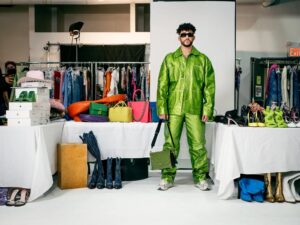
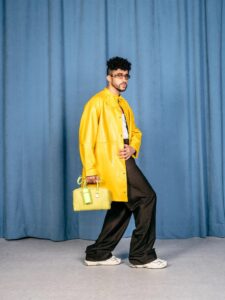
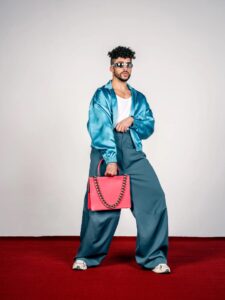
Switching gears to examine the performance of wealth in combination with gender fluidity, Bad Bunny’s feature in Vogue’s “Bad Bunny Models the Season’s Best Bags” represents yet another milestone in his fashion trajectory. The decision to highlight a male reggaetonero modeling luxury handbags—a traditionally feminine accessory—demonstrates a clear blending of gender expression with displays of material success. In this editorial, Bad Bunny pairs designer handbags from high-end brands, such as Louis Vuitton, Loewe, and Alexander McQueen, with soft, fluid silhouettes and bold colors. This feature not only cements his status as a global fashion icon but also emphasizes his ability to navigate the intersection of gender and wealth. Within the context of the reggaeton industry, the choice to feature Bad Bunny is revolutionary. It challenges the standard image of a reggaetonero tied to flashy jewelry, sneakers, and streetwear, choosing instead to visualize him as a sophisticated figure who embraces gender fluidity while maintaining a strong connection to wealth in a subtle, quiet way that strays away from the genre’s traditional wealth-flaunting. Vogue’s decision to cast him for this feature reflects an acknowledgment of his role in redefining not only reggaeton’s image but also the broader cultural understanding of masculinity and its relationship to wealth.
A Reggaetonero and Jacquemus:
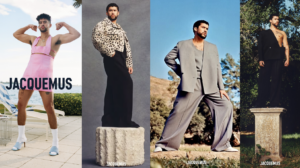
Bad Bunny’s collaboration with Jacquemus, a high-fashion French brand, marks another pivotal moment in his evolution as a fashion trailblazer, seamlessly integrating gender fluidity and wealth into his self-expression while breaking traditional norms. The campaigns feature him in minimalist yet overtly feminine designs, such as a pink minidress paired with kitten heels, a leopard print jacket, and reimagined suit structures, including off-the-shoulder and backless designs. The juxtaposition of hypermasculine body language, such as flexing muscles, with delicate, feminine garments, further showcases his defiance of traditional hypermasculine ideals. This transition into high fashion has clearly helped visualize the role wealth has played in enabling his style evolution. It certainly calls into question whether his previous cultural capital, rooted in Puerto Rican trap culture, would have supported such high fashion campaigns or whether brands like Jacquemus would have sought his collaboration given his early fashion choices. Now, with immense global influence, these campaigns not only amplify his identity but also challenge the conventions of luxury fashion and pop culture, celebrating gender nonconformity on an international stage.
The Met Gala:
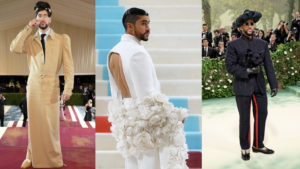
Bad Bunny’s consistent presence at the Met Gala for the past three years is a culmination of his fashion journey, providing him a global platform at the most exclusive fashion party in the world. He has used this opportunity to showcase outfits that yet again challenge gender norms through bold choices, such as a long suit-skirt combination with exaggerated shoulders and gold hairpieces (2022), a backless white suit adorned with a floral train (2023), and an intricately tailored corset-suit (2024). In the Vogue video “Bad Bunny Gets Ready for the Met Gala,” he reveals that shopping with his mother and being more interested in the women’s section of clothing stores as a child shaped his understanding of fashion and identity. He articulates that Bad Bunny, as a persona, has allowed him to explore and express himself in ways that Benito never could. He has reached a point in his career and personal development where his options for self-expression are not bound by the hegemonic standards of masculinity. These invitations to the Met Gala, as well as his 2024 nomination as a Co-Chair, are symbolic of how his groundbreaking gender-fluid fashion choices are not only celebrated but have also elevated his status in popular culture.
Conclusion:
Bad Bunny’s evolution in fashion represents a dual performance of gender fluidity and wealth that challenges the hypermasculine norms of Latin trap and reggaeton. By incorporating feminine elements into his wardrobe in music videos like “Caro” and “Yo Perreo Sola,” collaborating with luxury brands like Jacquemus, or making bold statements at the Met Gala, he has redefined what it means to be a male artist in a genre known for its traditional macho figure and rigid masculinity. These choices not only highlight his personal journey of self-expression but also reveal how his success and visibility can be leveraged to comfortably and overtly disrupt societal norms. His ability to balance performances of fluidity and luxury has elevated him from a reggaetonero to a global cultural icon, with implications that extend beyond music into fashion, media, and popular culture at large.
Bad Bunny’s fashion choices open conversations about the limitations of traditional masculinity, offering a vision of reggaeton where individuality, fluidity, and advocacy are embraced. His trajectory challenges the perception that Latin trap and reggaeton must conform to gender roles or hypermasculine tropes, encouraging a more inclusive and expressive future for these genres. Moreover, his ability to blend these conversations with statements of luxury signals a shift in the way wealth and success are performed.
Future generations of male trap and reggaeton artists can find comfort in self-expression and form a dominant hegemony in fashion that denaturalizes hypermasculinity. But it must be considered whether such artists will employ similar forms of expression and individuality or if Bad Bunny’s fashion evolution will remain an outlier. How can the broader music and fashion industries continue to challenge the gender norms and ideas of wealth that Bad Bunny has worked to dismantle? Who is next, and what route will they take in their journey through fashion?
Works Cited:
“Bad Bunny Gets Ready for the Met Gala.” Youtube, uploaded by Vogue, 4 May 2023, https://www.youtube.com/watch?v=see8-tsT2as
Barnard, Malcolm. (1996). “Fashion, Clothing, and Meaning.” Fashion as Communication, Routledge, pp. 72-100.
Betancourt, Bianca. (2022). “Bad Bunny Is the Star of Jacquemus’s New Spring Campaign.” Harper’s Bazaar, 7 February 2022.
“Caro.” YouTube, uploaded by Bad Bunny, 23 January 2019, https://www.youtube.com/watch?v=bg64AFnRnkc
Garcia-Furtado, Laia. (2022). “Bad Bunny Models the Season’s Best Bags.” Vogue, 19 January 2022.
Herrera, Isabelia. (2018). “Bad Bunny Says He Was Refused Service at a Nail Salon for Being a Man.” Remezcla, 23 July 2018.
Mau, Dhani. (2024). “Bad Bunny Is A Work Of Art In New Jacquemus ‘Les Sculptures’ Campaign.” Fashionista, 12 February 2024.
Rivera Figueroa, Luis. (2021). “Bad Bunny’s Transgressive Gender Performativity: Camp Aesthetics and Hegemonic Masculinities in Early Latin Trap Music.” Journal of Latin American Communication Research, vol. 8, no. 1-2, 13 July 2021.
Takanashi, Lei & Destefano, Mike. (2023). “Tracking Bad Bunny’s Evolution Into A Modern Style Icon.” Complex, 11 May 2023.
Wilbekin, Emil. (2020). “Great Aspirations: Hip-Hop and Fashion Dress for Excess and Success.” Fashion Theory, Routledge, pp. 355-360.
“Yo Perreo Sola.” YouTube, uploaded by Bad Bunny, 27 March 2020, https://www.youtube.com/watch?v=GtSRKwDCaZM
